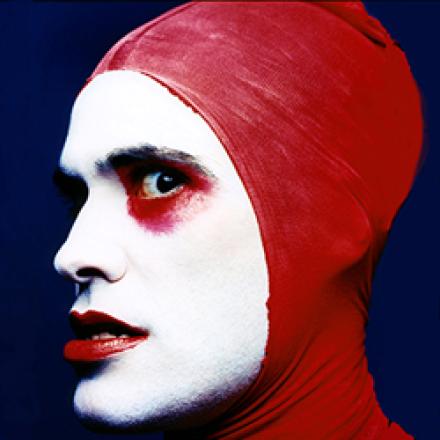
I thought of Dr Brown’s prize-winning performance during Karl Stets’ Cuerdo in Tournai. At one point the shaven-headed, Denmark-born artist got down from the stage and clambered over the audience to select a long-haired ‘victim’ to use her hair to cover his bald pate, much to the amusement of everybody who had not been selected. This was very much the kind of immersive, interactive approach Dr Brown takes in his comedy show.
When Dr Brown does this, though, the audience is terrified as well as amused. He is more like King Kong on the rampage. When Stets did it there was a zen-like grace, as there was to a lot of his humour. With his hairless head, bare feet and robe-like outfit he is part-clown, part-Shaolin monk.
Stets also reminded me of another comedian who was well-known on the London comedy scene a few years ago. Les Bubb’s party trick was to wrap elastic bands around his face, twisting his features into a grotesque grin, part-Frankenstein, part-Quasimodo. Stets does a lot of tricks with a piece of rope – turning it into a walking stick or a snake or a pair of glasses. At one point he wrapped fishing line around his face, turning himself into a monster in the same way Bubb did, once again blurring the barriers and definitions of what is circus, what is mime and what is comedy. Stets’ old gag of popping a (fake) goldfish into his bag and a splash of water coming out is probably descended from a music hall gag that is almost as old as Joseph Grimaldi.
Clowns, stand-up comedians, mime artists, circus performers – they all draw on a similar pool of ideas today. The winner of the Best Newcomer Award at the Edinburgh Festival Fringe in 2012 was Daniel Simonsen. He was more of a conventional storytelling, observational comedian, but like a classic clown he too made great use of physical movement and precision in his act. In fact it was not a surprise to discover that both Dr Brown and Simonsen had studied physical theatre at École Philippe Gaulier in Paris. Burgers also studied at the Nouveau Clown Institute in Barcelona. He then mastered his craft doing short appearances on the London comedy club circuit, but he could just as easily have joined a circus.
This cross-fertilisation of disciplines makes both circus and stand-up comedy more exciting than ever and it is clearly an ongoing process. On my return to London I was looking on the internet for local comedy shows to go to and discovered that Chris Lynam was doing a one-off show at my local pub in south London. Lynam is a veteran of the British alternative comedy scene of over thirty years. He is best known for closing his stage act by inserting a firework between his buttocks and lighting it.
Lynam was always a performer who marched to the beat of his own drum, but in recent years he has helped to bridge the gap between stand-up comedy and circus by introducing more familiar elements of the clown act into his club shows,
using props such as ladders onstage to create sublime solo knockabout sketches. He took a break from the comedy circuit a while ago to moonlight as a ‘real’ clown. As well as teaching clowning, he has been a part of famous Russian clown Slava Polunin’s ensemble when they have performed his timeless Snowshow. Polunin has called Lynam “one of the world’s funniest clowns”.
All of this suggests that maybe circus is about to break through in the United Kingdom but not necessarily in the way that was expected. Perhaps the stand-up comedy world will embrace circus in a way that the theatrical world has been reluctant to. The dramaturgy of British theatre, which relies so much on text, has a natural resistance to an artform that is more about performance than what is written down. Clowning has more in common with stand-up comedy – both make a much more direct emotional connection with their audience.
Circus is often seen as a ‘poor relation’ among editors of newspaper arts sections, struggling for coverage in the mainstream press. Cirque Du Soleil is one of the few circus companies that are widely reviewed by the British mainstream press, but the slapstick clowns are often dismissed by high-minded critics as if they are intended purely for the amusement of toddlers hauled along by their parents.
Every year Charles Spencer, the esteemed theatre critic of the Daily Telegraph, finds a new way to mock the Soleil funny men. In 2005 he opened his review of Dralion at the Royal Albert Hall by writing: “If there is a more depressing phrase in the English language than ‘zany clown routine’ I have yet to come across it.” Maybe it is time for the likes of Charles Spencer to take comedy more seriously.
Pages
- « first
- ‹ previous
- 1
- 2
- 3


